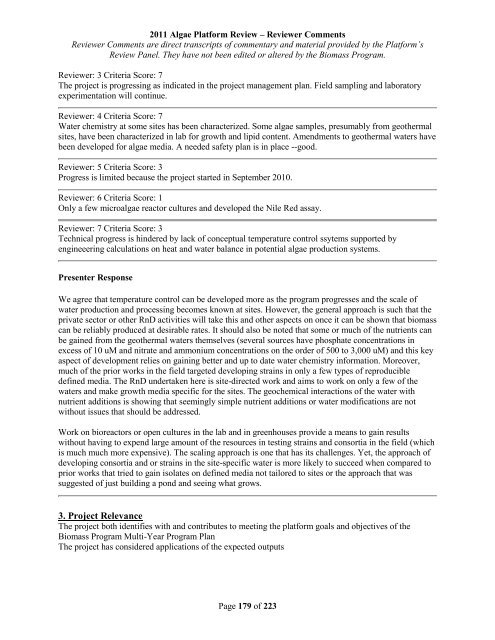Reviewer Comments - EERE
Reviewer Comments - EERE
Reviewer Comments - EERE
Create successful ePaper yourself
Turn your PDF publications into a flip-book with our unique Google optimized e-Paper software.
2011 Algae Platform Review – <strong>Reviewer</strong> <strong>Comments</strong><br />
<strong>Reviewer</strong> <strong>Comments</strong> are direct transcripts of commentary and material provided by the Platform’s<br />
Review Panel. They have not been edited or altered by the Biomass Program.<br />
<strong>Reviewer</strong>: 3 Criteria Score: 7<br />
The project is progressing as indicated in the project management plan. Field sampling and laboratory<br />
experimentation will continue.<br />
<strong>Reviewer</strong>: 4 Criteria Score: 7<br />
Water chemistry at some sites has been characterized. Some algae samples, presumably from geothermal<br />
sites, have been characterized in lab for growth and lipid content. Amendments to geothermal waters have<br />
been developed for algae media. A needed safety plan is in place --good.<br />
<strong>Reviewer</strong>: 5 Criteria Score: 3<br />
Progress is limited because the project started in September 2010.<br />
<strong>Reviewer</strong>: 6 Criteria Score: 1<br />
Only a few microalgae reactor cultures and developed the Nile Red assay.<br />
<strong>Reviewer</strong>: 7 Criteria Score: 3<br />
Technical progress is hindered by lack of conceptual temperature control ssytems supported by<br />
engineeering calculations on heat and water balance in potential algae production systems.<br />
Presenter Response<br />
We agree that temperature control can be developed more as the program progresses and the scale of<br />
water production and processing becomes known at sites. However, the general approach is such that the<br />
private sector or other RnD activities will take this and other aspects on once it can be shown that biomass<br />
can be reliably produced at desirable rates. It should also be noted that some or much of the nutrients can<br />
be gained from the geothermal waters themselves (several sources have phosphate concentrations in<br />
excess of 10 uM and nitrate and ammonium concentrations on the order of 500 to 3,000 uM) and this key<br />
aspect of development relies on gaining better and up to date water chemistry information. Moreover,<br />
much of the prior works in the field targeted developing strains in only a few types of reproducible<br />
defined media. The RnD undertaken here is site-directed work and aims to work on only a few of the<br />
waters and make growth media specific for the sites. The geochemical interactions of the water with<br />
nutrient additions is showing that seemingly simple nutrient additions or water modifications are not<br />
without issues that should be addressed.<br />
Work on bioreactors or open cultures in the lab and in greenhouses provide a means to gain results<br />
without having to expend large amount of the resources in testing strains and consortia in the field (which<br />
is much much more expensive). The scaling approach is one that has its challenges. Yet, the approach of<br />
developing consortia and or strains in the site-specific water is more likely to succeed when compared to<br />
prior works that tried to gain isolates on defined media not tailored to sites or the approach that was<br />
suggested of just building a pond and seeing what grows.<br />
3. Project Relevance<br />
The project both identifies with and contributes to meeting the platform goals and objectives of the<br />
Biomass Program Multi-Year Program Plan<br />
The project has considered applications of the expected outputs<br />
Page 179 of 223




